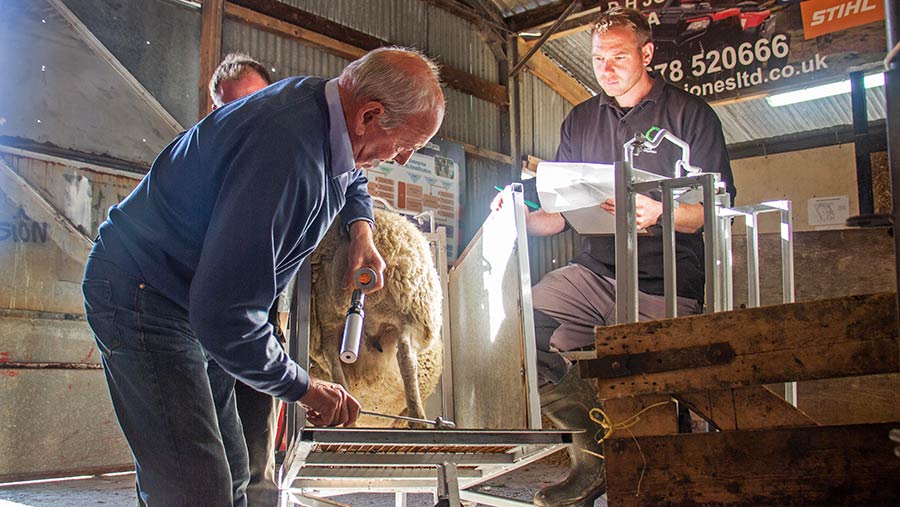Sheep AI trial shows frozen semen possibilities
 Alwyn Phillips inseminates the ewes
Alwyn Phillips inseminates the ewes Farmers wishing to improve conception rates by using cervical insemination in combination with frozen semen could learn from a recent Farming Connect study.
Cervical AI using fresh semen is not uncommon, but this technique in combination with frozen semen – an approach that provides farmers with access to superior genetics and reduces risks of importing diseases – is rare in the UK due to poor conception rates.
Instead, most sheep are inseminated laparoscopically, but this is a high-cost and invasive procedure with associated risks.
Scandinavian countries have become world leaders in the cervical insemination of sheep using frozen semen because laparoscopic AI is prohibited. They regularly achieve conception rates of 50-70%.
In order to investigate the factors influencing the efficacy of impregnating ewes with frozen semen, Llysfasi College, a Farming Connect Innovation Site near Ruthin, trialled cervical insemination this season.
See also: Guide to breeding from ewe lambs
The trial process
Breeding was synchronised in 50 mixed-age Welsh Mules ewes from the 1,200-head flock.
This group was inseminated in mid-October with semen from performance-recorded Texel and Norwegian White rams, at a cost of £37 a head for the synchronisation and semen.
The insemination at Llysfasi was carried out by Alwyn Phillips, who has used cervical insemination in combination with fresh semen since 1983 on his flock of performance-recorded Texels and Poll Dorsets.
Mr Phillips, of Penygelli Farm, near Caernarfon, had visited Denmark and Sweden, two countries that achieve high conception rates using frozen semen.
The group has now started lambing, and the results show that 10% of the group held to AI. The other pregnant ewes are in-lamb to a sweeper ram introduced 14 days after AI. Ewes that held to AI all produced singles.
Despite disappointing results at their first attempt, the team involved are confident the that AI conception figures can be improved.
Farming Connect’s Red Meat Technical Officer for North Wales Gethin Prys Davies, who co-ordinated the trial, says data suggests the timing of insemination could be key to achieving higher conception rates.
“The initial plan was to start inseminating 55 hours after the removal of the CIDRs (devices to increase blood progesterone concentrations), but we found the ewes were coming into heat quicker than anticipated – 37 ewes were marked by paint from the teaser ram after 50 hours,’’ he explains.
“As a result of this, we brought the insemination time forward from 3pm to 12 noon, 52 hours after the ewes were injected.
“The results suggest that this revised time was still too late, and we should have gone earlier, as four of the five ewes that held to AI were inseminated between 52 and 53 hours.’’
Lessons learned
Mr Davies says Farming Connect will repeat the trial in the next breeding season, with changes introduced to reflect the data gathered this year. This year, the changes will include:
- The insemination time will be moved forward – probably starting around the 48-hour mark.
- The diluent used to freeze the semen won’t include egg yolk – the straws that included a diluent free from egg yolk and pioneered in Norway performed better than those that were egg yolk-based.
“The end goal is to develop this technique to a point where it is commercially viable for the farmer. We are not there yet, but this has given us a true sense of optimism and excitement for future progress in sheep breeding,” adds Mr Davies.
Llysfasi farm manager Dewi Jones says the farm had been pleased to be involved in the trial.
“If we can make cervical AI with frozen semen work, it is potentially a way of speeding up genetic progress in ewe flocks as has been achieved in the beef and dairy industries,’’ he says.
